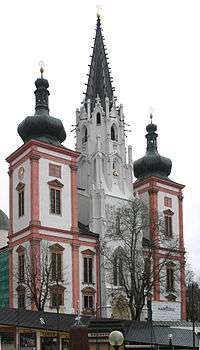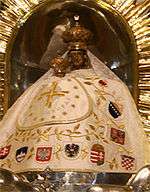Mariazell Basilica
Mariazell Basilica, also known as Basilica Mariä Geburt (Basilica of the Birth of the Virgin Mary), is a Marian basilica in Mariazell, Austria. It is the most important pilgrimage destination in Austria and one of the most visited shrines in Europe.[1] In the church, a miraculous wooden image of the Virgin Mary is honored. Pope Pius X raised the sanctuary to the status of minor basilica in 1907 and then crowned the image on 8 September 1908. It is the only church named as a national shrine of all German-speaking countries.
| Mariazell Basilica | |
|---|---|
Mariazell Basilica | |
| Religion | |
| Affiliation | Catholic Church |
| Ecclesiastical or organizational status | Basilica |
| Status | Active |
| Location | |
| Location | Mariazell, Austria |
| State | Styria |
 Shown within Austria | |
| Geographic coordinates | 47.7729°N 15.3184°E |
| Architecture | |
| Architect(s) | Domenico Sciassia |
| Type | Church |
| Style | Gothic, Baroque |
| Groundbreaking | 1644 |
| Completed | 1683 |
Early history
The territory around Mariazell was given to the Monastery of St. Lambrecht around 1103, and the monks built a cell there in order to serve the local residents. Legends give the town's founding day as December 21, 1157, but it is first documented in 1243. A Marian altar was dedicated there in 1266.
The current church building
The Basilica of the Mariä Geburt
In the fourteenth century, a gothic church stood at Mariazell with a 90 m high spire and an ogive portal. In 1420 and 1474, the church was destroyed by fire. The church building was later expanded and redesigned in the Baroque style by Domenico Sciassia from 1644 to 1683. To the left and right of the gothic spire, a baroque tower was built, the nave was lengthened and widened, and a dome was added on the eastern side. The high altar, consecrated in 1704, was designed by Johann Bernhard Fischer von Erlach.
The twelve side chapels each contain a baroque altar. The plaster stucco work of the organ gallery and the 1737 organ console was created by the Viennese sculptor Johann Wagner in 1740.
In front of the main entrance are two life-sized lead statues created by Balthasar Moll in 1757. To the left stands King Ludwig I of Hungary and to the right is Heinrich, Margrave of Moravia.
In 1907, the pilgrimage church was elevated to a basilica minor.
The basilica has been undergoing a general restoration since 1992, which was completed in 2007[2].
Holy image and chapel
The older part of the building, built in 1690, contains the Gnadenkapelle. This chapel sits on the site of the first "cell" and holds a Late Romanesque miraculous image of the Virgin Mary - the "Magna Mater Austria" - a 48 cm tall statuette made of linden.
Pilgrimage development
Pilgrims were already making their way to the Marian sanctuary in the 12th century. Larger numbers of pilgrims are documented beginning around 1330, when a secular court imposed a "Zellfahrt" ('Zell journey) as atonement for its criminals. In the following years increasing numbers of pilgrims came from neighboring lands. After the Counter-Reformation, the Habsburgs made Mariazell a national sanctuary. However, in 1783, Emperor Joseph II dissolved the monastery in Mariazell, and in 1787, he completely banned pilgrimages there. After the early withdrawal of the restrictions, today around a million pilgrims visit Mariazell each year. In May 2004, the Central European Catholic Day (mitteleuropäische Katholikentag) took place there.
Legends
There are three basic legends about the founding of Mariazell and its development. The legend of the town's founding says that in 1157, the St. Lambrecht Monk Magnus was sent to the area of the current town as a minister. When his way was blocked by a rock, he set down the Marian figurine he had brought with him, whereby the rock broke apart and left Magnus' way clear. On a nearby bank, he settled down, placed the figurine on a tree trunk, and built a cell out of wood, which served as both his chapel and his living quarters.
The second legend relates how Henry Margrave of Moravia and his wife, having been healed of severe gout through the help of Our Lady of Mariazell made a pilgrimage to that place around 1200. There they built the first stone church on the site of the wooden chapel.
The third legend recounts a victorious battle of the Hungarian King Ludwig I over a numerically superior Turkish army. Out of thanks he built the gothic church and endowed it with the "Schatzkammerbild" ("treasury image") that he saw laid upon his chest in a dream.
The Mariazell Basilica was recently selected as the main motif of a collectors' coin: the Austrian Mariazell Basilica commemorative coin, minted on May 9, 2007. The coin shows the facade of the basilica with its characteristic central gothic tower flanked by two baroque towers.
Gallery
 Basilica Mariä Geburt, Mariazell
Basilica Mariä Geburt, Mariazell- Gothic Portal
 Gnadenkapelle
Gnadenkapelle Magna Mater Austriae
Magna Mater Austriae Mariazell Basilica
Mariazell Basilica
See also
- Roman Catholic Marian churches
References
| Wikimedia Commons has media related to Mariazell Basilica. |
- Portions of the information in this article are a translation of its German equivalent.
- (in German) Mariazell Basilica
- (in German) Central European Catholic Day (mitteleuropäischer Katholikentag)
- (in German) Turmratsche in Mariazell